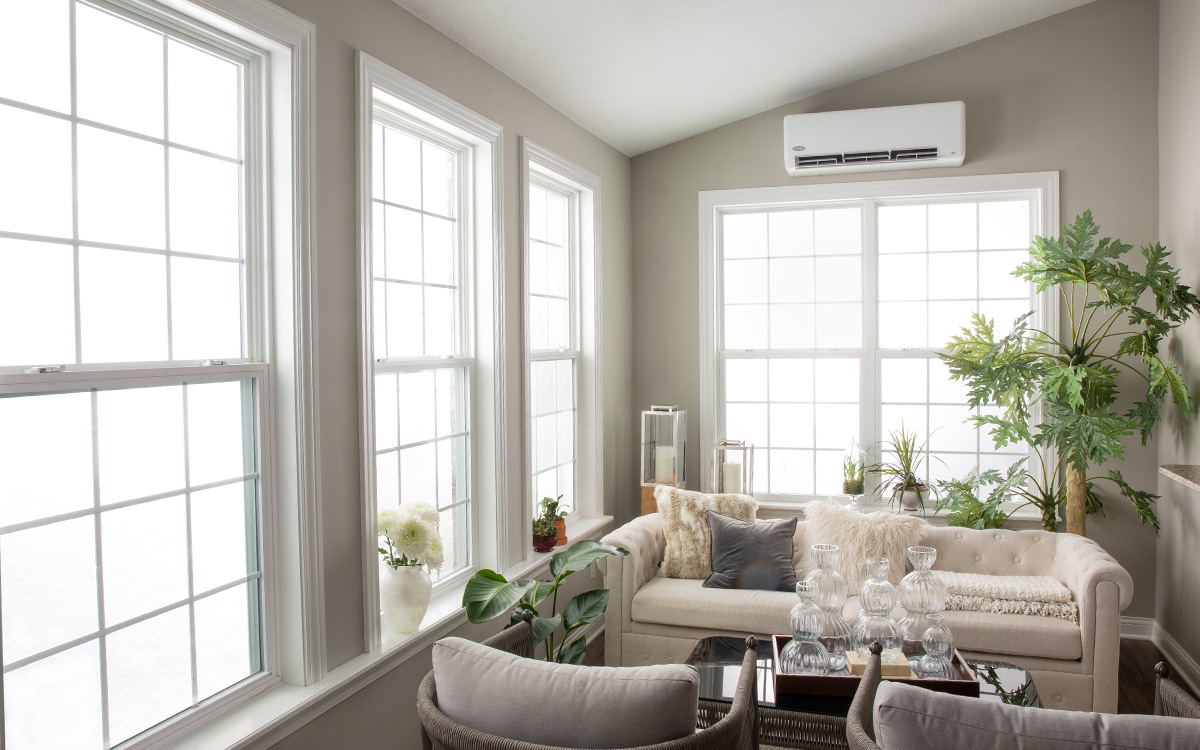
If you’re looking for a modern, efficient way to heat or cool your home, you might want to consider a ductless HVAC system.
Unlike traditional systems, ductless HVAC units offer a range of benefits that make them an appealing choice for many homeowners.
In this blog post, we’ll dive into everything you need to know about ductless HVAC installation, from how these systems work to their installation process, benefits, and the key considerations before getting started.
What is a ductless HVAC system?
A ductless HVAC system, also known as a mini-split system, is a heating and cooling solution that operates without the need for traditional ductwork. The system is composed of two main components: an outdoor compressor or condenser and one or more indoor air-handling units. These units are connected by a conduit, which houses the power cable, refrigerant tubing, suction tubing, and a condensate drain.
The indoor units are designed to deliver conditioned air directly into specific rooms or zones. They can be mounted on walls, ceilings, or floors, making them incredibly versatile and easy to fit into any home layout. This setup allows for targeted heating and cooling, which can lead to significant energy savings and a more comfortable home environment.
What are the benefits of ductless HVAC systems?
1. Energy Efficiency
One of the most appealing aspects of ductless HVAC systems is their energy efficiency. According to the U.S. Department of Energy, ductless systems can reduce energy consumption by up to 30% compared to traditional forced-air systems. This is primarily because ductless units eliminate the energy losses associated with ductwork, which can account for up to 30% of energy consumption in a typical home. So, if you’re looking to lower your energy bills, a ductless HVAC system could be the way to go.
2. Flexibility and Zoning
Ductless systems offer exceptional flexibility by allowing for customized temperature control in different areas of your home. You can heat or cool only the rooms you’re using, which can significantly cut down on energy costs. Each indoor unit can be independently controlled, giving you the ability to create different temperature zones for maximum comfort.
3. Improved Indoor Air Quality
Traditional HVAC systems can accumulate dust, allergens, and other pollutants in the ductwork, which are then circulated throughout your home. Ductless systems, however, have multi-stage filtration that can reduce dust, bacteria, pollen, and other particulates, thereby improving the overall indoor air quality. For those with allergies or respiratory issues, this can be a game-changer.
4. Easy Installation
Ductless HVAC installation is typically faster than traditional systems that require ductwork. They only require a small hole to be drilled in the wall for the conduit, which means there’s minimal disruption to your home. This simplicity also translates to lower installation costs and faster setup times.
5. Cost Savings
While the initial cost of a ductless system can be higher than a traditional HVAC system, many homeowners find that they save money in the long run. This is due to reduced energy bills, potential federal and state rebates, and lower maintenance costs. In other words, investing in a ductless HVAC system could be financially beneficial over time.
What does the installation process entail?
Ductless HVAC installation involves several steps to ensure the system is set up correctly for optimal performance. Here’s a breakdown of what you can expect during the installation process:
1. Consulting and Assessing
The first step is to schedule a consultation with a qualified HVAC contractor. The contractor will assess your home to determine the best locations for the indoor and outdoor units. They’ll also calculate the cooling and heating load and recommend the appropriate system size and configuration based on your home’s specific needs.
2. Choosing the Right System
Depending on the size and layout of your home, as well as your heating and cooling needs, the contractor will help you choose the right ductless system. For example, a single-zone system is ideal for smaller spaces or one-room additions, while a multi-zone system can serve multiple areas or an entire home.
3. Preparing for Installation
Before installation begins, the contractor will prepare the site by ensuring there is a suitable location for the outdoor unit with adequate airflow and clearance. For the indoor units, they will select locations that are accessible and unobstructed for optimal airflow.
4. Installing the Indoor Units
The indoor air-handling units will be mounted on walls, ceilings, or floors, depending on your preference and the system’s design. These units are installed using brackets and securely fixed to the chosen surface.
5. Connecting the Outdoor Unit
The outdoor unit is placed on a stable, level surface, such as a concrete pad or wall-mounted bracket. It should be positioned away from direct sunlight, debris, and vegetation to ensure proper airflow and efficient operation.
6. Running the Conduit
A small hole (about 3 inches in diameter) is drilled in the wall to connect the indoor and outdoor units. The conduit is threaded through this hole and securely sealed to prevent air leaks and protect against pests.
7. Testing the System
After all the components are installed, the contractor will connect the refrigerant lines, electrical wiring, and drainage system. The system is then thoroughly tested to ensure it is functioning correctly and efficiently, including checking for refrigerant leaks and verifying proper electrical connections.
8. Educating Homeowners
Finally, the contractor will provide a demonstration of how to use the system, including setting up the thermostat, adjusting airflow, and performing basic maintenance tasks like cleaning the filters.
What are the key considerations before installation?
1. Finding a Qualified Installer
It’s crucial to hire a licensed and experienced HVAC contractor familiar with ductless systems. In Pittsburgh, look for contractors who are NATE-certified (North American Technician Excellence) and have positive reviews from local customers.
2. Taking Into Account Cost and Rebates
The cost of ductless HVAC installation in Pittsburgh can average around $7,500, depending on the system’s size and complexity. However, you might be eligible for federal tax credits, utility rebates, or state incentives that can help offset some of the costs. Always check with your local utility company for available incentives.
3. Performing System Sizing and Efficiency
Proper sizing is critical for the system’s efficiency and performance. An undersized system may struggle to heat or cool your home adequately, while an oversized system can lead to short cycling and increased wear and tear. A qualified contractor will perform a Manual J load calculation to determine the right size for your home.
4. Ensuring Maintenance
Ductless systems require regular maintenance to operate at peak efficiency. This includes cleaning or replacing filters, checking refrigerant levels, and inspecting the outdoor unit for debris or damage. Fortunately, maintenance is relatively straightforward and can often be done by the homeowner with some guidance from the contractor.
Find a good contractor for ductless HVAC installation
While ductless systems are highly efficient, they may need additional support during Pittsburgh’s cold winters. Make sure the system you choose has adequate heating capacity and is rated for low ambient temperatures.
Ductless HVAC systems offer a modern, flexible, and energy-efficient way to keep your home comfortable year-round. By understanding the benefits, ductless HVAC installation process, and key considerations, you’ll be better equipped to decide if this system is the right choice for your home.
Get in touch with a good contractor for HVAC installation services today!

